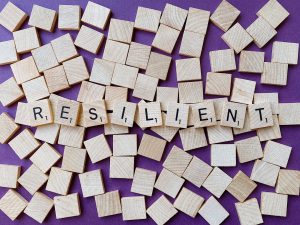Last year, we did the heavy lifting for you. After we decided that resolutions were for the birds, especially after the year we’d been through (anyone remember 2020??), we found something else to focus on as we glided (stumbled? collapsed?) into 2021: a word of the year. That word of the year was “resilience,” since it just seemed so fitting. This year, as we were searching for the exact right word for 2022, it hit us: it’s time for you to fly from the nest and find the exact right word for you.
That’s what 2022 is going to be all about: finding the version of you that you want to be, and your word of the year can be a mantra to bring you closer to that. Ditching the hollow resolutions and boiling your goals down to a word (or two, or three, or whatever works for you – hey, we’re flexible) can help you find your core purpose and bring you focus and clarity as we start anew in 2022. So how do you start the search?
Finding Your Word – and Your Purpose

Having goals and a purpose feels good, right? Turns out that might not be all in your head: some studies are now showing that a strong sense of meaning and purpose in your life is actually physically beneficial, as well as psychologically beneficial. For example, a study published in JAMA Current Open, found that people who didn’t have a strong life purpose – which was defined as “a self-organizing life aim that stimulates goals” – were more likely to die than those who did, and specifically more likely to die of cardiovascular diseases.
In the study, the relationship between having a lower level of purpose in life and death remained true no matter the income, gender, race, or education level of the participants. The researchers also found the association to be so powerful that having a life purpose appeared to be more important for decreasing risk of death than drinking, smoking, or exercising regularly – beats a vague resolution to go to the gym, doesn’t it?
So yeah, sounds like it’s time to sit down and think about what drives you, so you can feel centered, positively driven, AND bursting with vitality! Picking a word to come back to everyday throughout the year can be one big step in that direction, so let’s get started.
Step 1: Start Reflecting
The first step toward setting your intentions for next year is to actually reflect a bit on the year that has passed. Ask yourself how you felt about last year, and jot down your answers without doing any self-editing. You can also ask yourself the following questions:
- What is something I could improve upon, do differently, or keep working on?
- What’s something that wasn’t or isn’t going so well for me, and what would be the more positive alternative to this?
- By the end of the day I feel (blank), but I would like to feel (blank)
Step 2: Look Forward
Reflecting is important, but we’re looking for the word to spark your goals for the coming year, so you’ll also have to ask yourself some questions about what you want for yourself for 2022. Start jotting down your thoughts on this subject; you can get the juices flowing with questions like: 
- What do I want more of this year?
- What do I want less of this year?
- What would be a game-changer for me?
- What would my perfect day feel like (not what would happen on this day, but how I would feel)
- What are 5-10 goals in all areas of my life that I have for this year?
Step 3: Create a List
Now it’s time to take some time – say 10 minutes – and just go to town listing words that come to mind. Again, do your best not to self-edit – you’re going to refine this list, but for now, you’ve got to set yourself totally free. Your list might include words like compassion, free, fierce, abundance, passion, surrender, fire, forgive, aware, uncomfortable, vitality, force, explore, action, generous, fearless, commit, etc, etc – the sky’s the limit!
Step 4: Refine Your Goals and Your List
Look back at your goals that you jotted down for this year: can you find a pattern in them? Look at your list of words: can you narrow it down to a shortlist of favorites that seem to run on a common theme? Do your shortlisted words fit in with the pattern you see in your goals?
Once you’ve found some overlap, look at your remaining words: are there any that jump off the page at you, make you feel excited, nervous, scared, uncomfortable, or at ease? Being a bit scared or uncomfortable with one of your favorite words is not necessarily a bad thing – after all, change isn’t easy, and feeling growing pains is natural! On the other hand, if you’re looking for something to bring you peace or empower you, feel out words that give you those feelings.
Think about your words, but don’t over-analyze, just trust your gut and go with what feels right. It might help to think about the type of word you want to choose: for example, your word can promote action (verbs like “leap” or “rise”), intensify or describe (adjectives like “calm” or “fierce”), or focus on something concrete (nouns like “home” or “family”).
And remember, no one’s going to judge you for switching words halfway through the year! Sometimes you’ve just got to roll with the punches.
Step 5: Commit to Your Word, and Use It!

Hopefully you’ve chosen your word (or maybe it has chosen you!). Now’s the time to think about this: are you just interested in thinking about this word throughout the coming months, or do you feel committed to it? Interested means you might end up making excuses not to use your word, but committed means you’re more likely to work at making it a part of your daily life. In other words, your word should be actionable, and something you can and want to take daily action on.
So once you’ve committed to your word, make a plan for how you are going to use it, remembering that your one word can have many meanings and many actions related to it, especially as you apply it to all facets of your life. Keep your word near you so it is always in your mind. You can put it on your phone’s locked screen, write it on your bathroom mirror in dry-erase marker, put it on a prominent place on your desk, or keep it written on your journal/planner, so it’ll always be there to help you set your little goals and focus your day.
No one could have predicted what 2020 had to throw at us, and for many, 2021 wasn’t really all that hot, either. But now we’ve got a whole new year stretching ahead of us, full of promise and potential, so why not grab hold of it, and do your best to make it what you want it to be? You might not be able to control the events of the world that shape your year, but you can sure try to shape how you act and react as those events unfold around you – and having a word of the year in your pocket might just be one way to do that. Happy New Year, everyone! And don’t forget to tell us what YOUR word of the year is!







